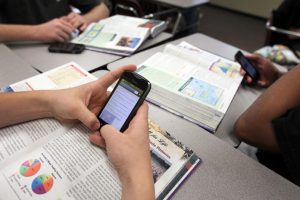In the near Future; Should we Prohibit the usage of Smart Phones in the Classroom?
Even at elementary school age, children today have smartphones. They were practically born into the information age and everything they do basically revolves around technology. Due to this effect, schools are now beginning tap inculcate smart phones and mobile devices as ways to improve their classroom experience and make students learn better. Apart from schools, other learning centers use smart phones too. The materials to be taught are made into soft copies and students can follow up as the facilitators are teachingIt is also important to know that schools or learning centers have different approaches as to the notion of using smart phones in classrooms. Some are totally against it because it could cause a great deal of distraction among students. While others think that it is a great tool to help students participate more in class.
Uses of smart phones in the class
Smart phones in classrooms can be used for the following purposes:
To read comprehension passages.
To take pictures and record voice/videos of classroom events.
To interact better with classmates and teachers.
To have better visuals of graphs and charts.
Examples of how smart phones can be used in classrooms
An example of how smartphones can be used in classrooms can be seen when students see experiments on YouTube in chemistry or physics lessons, or in physical education where they record movements and evaluate them. In the future, many education experts agree, it will be less a question of whether smartphones can be used in school, but rather which methods of integration into the classroom could be the best.
Apps to use in the classroom
With good monitoring, students can use social media apps like Twitter, Facebook and Instagram as platform for class discussions on topics already treated in class. In fact, apps like twitter will reduce the characters you use so students can only go straight to the point. Apart from these social media apps, there are other apps to use that will make students participate fully in class.Smartphones can even be integrated even better if a school's IT infrastructure is able to connect individual mobile devices to the whiteboard or projector in the classroom. In such a collaborative classroom, students can follow and edit blackboard images on their smartphones or present their own content on the large blackboard. Ideally, students without a smartphone can work on the task together with the classmates who have a device at their disposal.
Bans on smartphones in classrooms
As earlier stated, many schools are still a long way from integration of smartphones in the classroom. According to a research done in Germany, two thirds of young people report that the use of mobile phones in the classroom is prohibited. In New York, such regulation was lifted in schools in early 2015 after parents put pressure on schools because they worried that they could no longer reach their children via their smartphones.
Conclusion
The use of smartphones in classrooms is a major way forward, as it helps to broaden the scope of both the teacher and the student, making students understand more and grasp the content of what is being taught. However, it should be done with a lot of monitoring as students can be mischievous and could tend to drift or lose focus once they are left in their own with their smart phones.References:https://www.netzwerk-digitale-bildung.de/information/schule/smartphones-im-unterricht/https://www.lehrer-online.de/artikel/fa/smartphones-im-unterricht-schueler-zeigen-was-moeglich-ist/https://oe1.orf.at/programm/20180403/509817http://www.faz.net/aktuell/wirtschaft/smartphone-im-klassenzimmer-zeit-fuer-digitale-medien-in-der-schule-13481765.html


